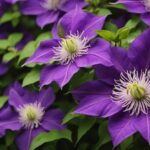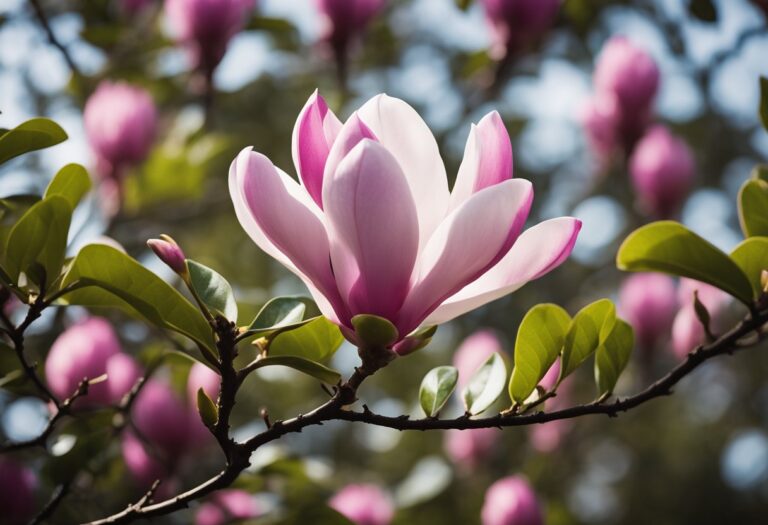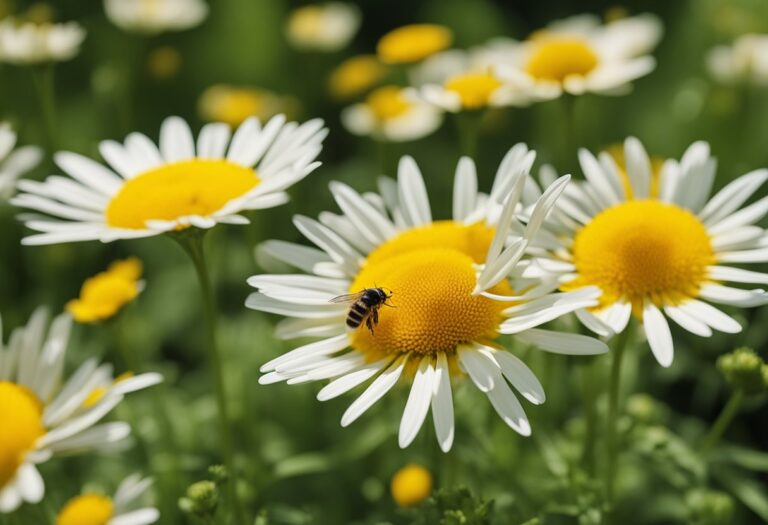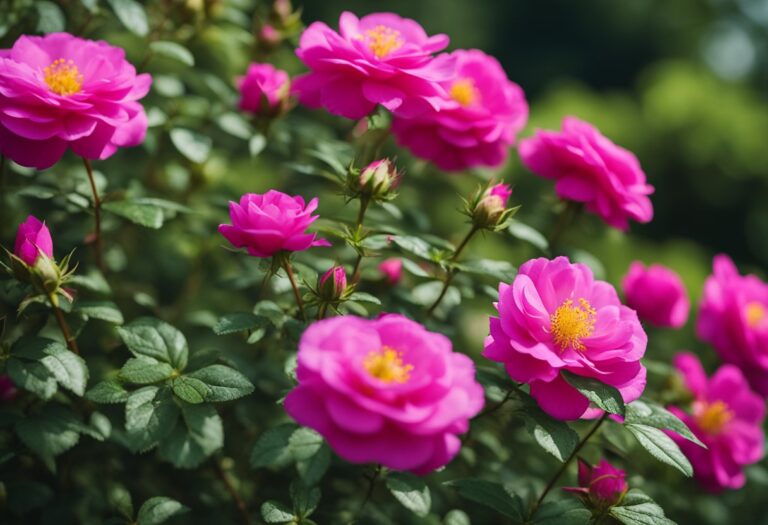Overview of Eryngium Yuccifolium
Eryngium yuccifolium, commonly known as Rattlesnake Master, is an intriguing perennial native to the Central and Eastern United States. It’s part of the parsley/carrot family, Apiaceae, but unlike its relatives, it does not feature finely cut foliage. Instead, you’ll recognize Rattlesnake Master by its sword-shaped, spiny-edged leaves, which are blue-gray and resemble that of yucca plants.
Key Characteristics:
- Flowers: Small, greenish-white flowers clustered into 1-inch, egg-shaped flowerheads, surrounded by white pointed bracts.
- Height: Typically grows between 4 to 5 feet tall.
- Spread: Can reach a width of 2 to 3 feet.
In its natural habitat, you may find Rattlesnake Master thriving in rocky woods, prairies, and glades. It particularly flourishes in the once common tallgrass prairies.
Growing Season:
- Bloom Time: Flowerheads appear in mid-summer, creating a striking visual interest.
- Attractiveness: Attracts pollinators such as bees, butterflies, and moths with its unique flowers.
Given its origins and adaptability, Rattlesnake Master is a hardy plant suited for dry to moist conditions and full sun. Historically, its common name is rooted in its purported medicinal use by Native Americans.
Transplant it with care or sow directly into your garden, as Eryngium yuccifolium seeds benefit from cold stratification, which simulates winter conditions before spring planting.
Habitat and Distribution
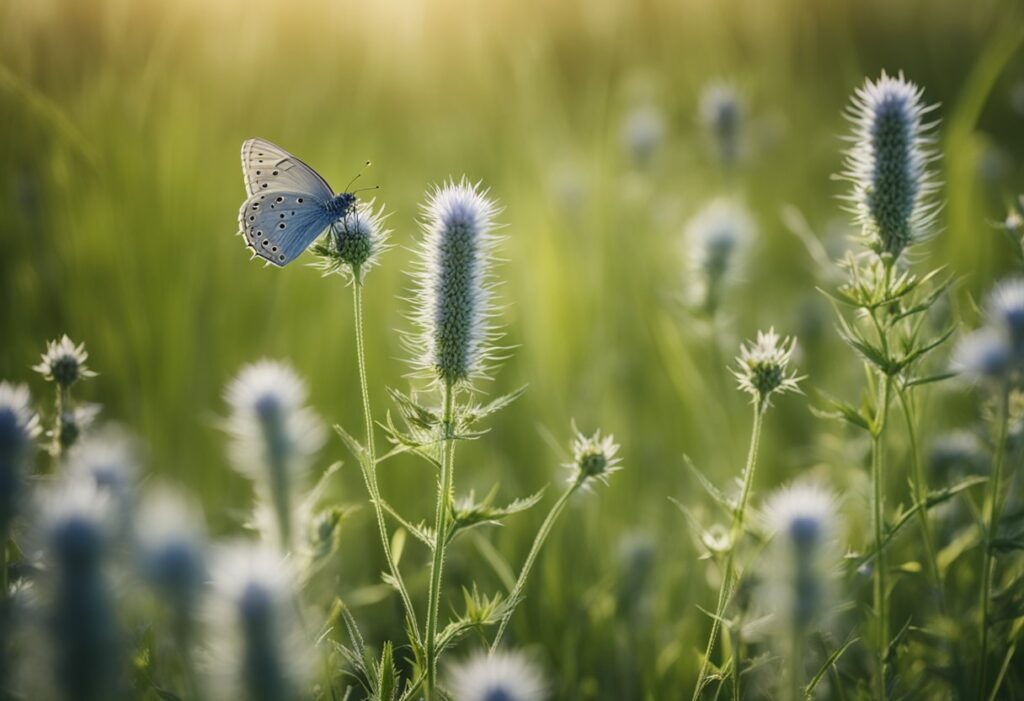
Rattlesnake Master, also known by its scientific name Eryngium yuccifolium, is a plant that was commonly found in North America’s prairies. In this section, you’ll discover where this species is naturally found and the types of habitats it prefers.
Native Range
Rattlesnake Master is native to a significant portion of the Central and Eastern United States. Historically, it was a characteristic species of the tallgrass prairie, a biome that once covered vast areas across several states.
- Historical Coverage: Included regions such as Texas, Nebraska, and reaching up to the Great Lakes.
- Present Distribution: Despite habitat reductions, it is still found across its native range, including states like Missouri.
Habitat Preferences
Your Rattlesnake Master displays a preference for specific environmental conditions that are reflective of its prairie heritage.
- Soil Type: Thrives in well-drained soils, with occurrences in sandy soils and wet prairies.
- Locations: Commonly found in sedge and grass-dominated areas, former oak savannas, oak barrens, and modern-day remnants alongside railways and under power lines.
- Ecosystems: Gain a foothold in various ecosystems like rocky woods, prairie fen complexes, and glades.
Botanical Characteristics
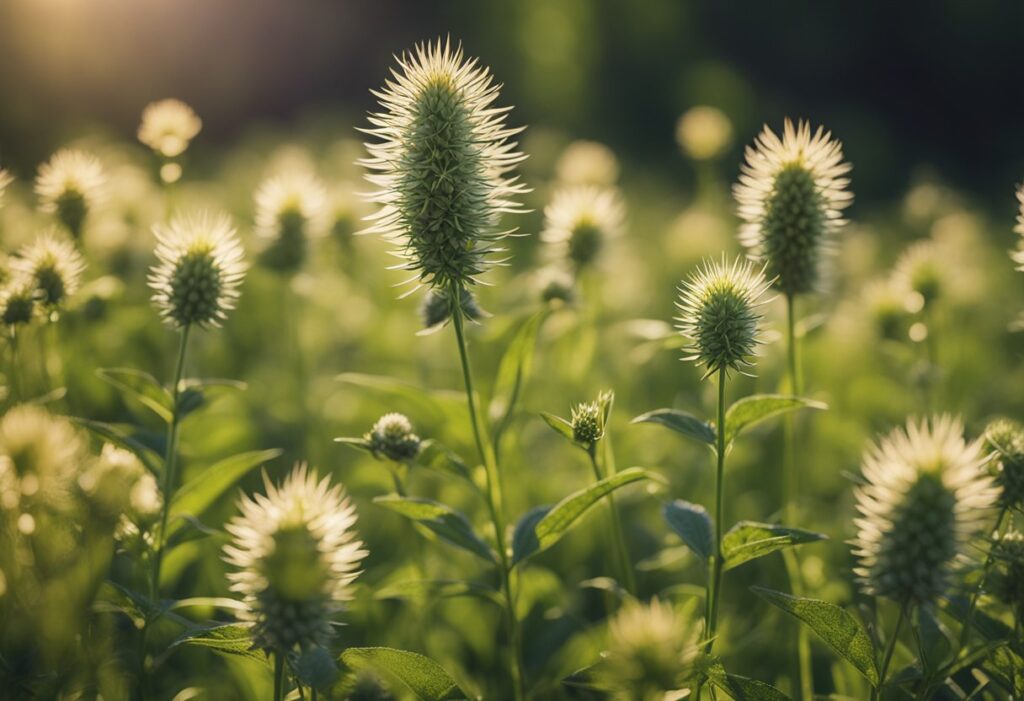
Eryngium yuccifolium, known as the Rattlesnake Master, exhibits unique structures and reproductive features adapted to its environment. Your knowledge of its botanical characteristics is essential for understanding this hardy perennial.
Morphology
Leaves: You’ll notice the yucca-like, blue-gray leaves featuring spiny edges. They form a basal rosette and are known for their sword-shaped, fibrous texture.
Stems: Expect to find smooth, stiff, and branched stems. The plant typically grows 4 to 5 feet tall and spreads 2 to 3 feet wide.
Flowerheads: The Rattlesnake Master produces clusters of egg-shaped flowerheads that measure approximately 1 inch across. These flowerheads are tightly packed with tiny greenish-white flowers.
Reproductive Features
Flowering Period: Your Rattlesnake Master will show its greenish-white flowers usually from July to September.
Pollination: With hermaphroditic flowers—containing both male (stamens) and female (pistils) parts—the plant can self-pollinate or attract pollinators such as insects.
Ecological Impact
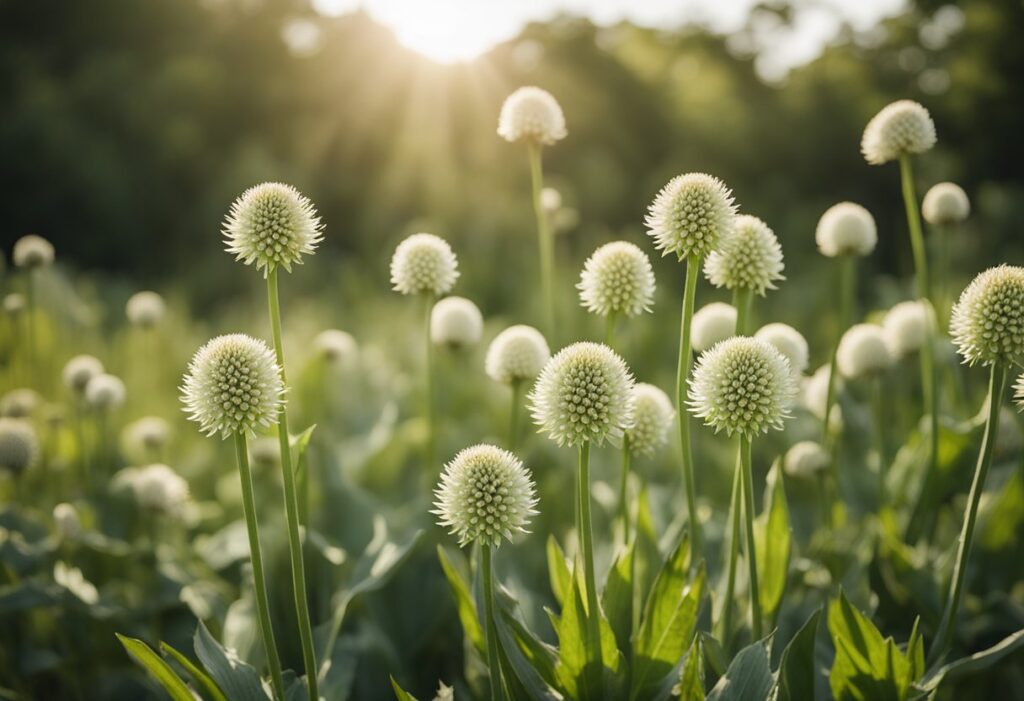
Eryngium yuccifolium, commonly known as Rattlesnake Master, plays a significant role in your local ecosystem, particularly in the prairie and savanna habitats of the central and eastern United States. As you incorporate this native perennial into your environment, it’s essential to understand its contribution to local biodiversity and ecological stability.
- Pollinator Support: Rattlesnake Master serves as an attraction for various pollinators, including bees and butterflies. Its distinctive flowers provide essential nectar sources and contribute to the pollination of nearby plants, maintaining species diversity and promoting healthy plant populations.
- Habitat Quality Indicator: When you observe Eryngium yuccifolium thriving in the wild, it often indicates a high-quality remnant prairie or barrens. Its presence reflects the health of these ecosystems.
- Prairie Restoration: Integrating Rattlesnake Master into prairie restoration projects can help reestablish the ecological balance. This strategy aids in re-creating the complex web of interactions among native flora and fauna that constitutes a functioning prairie ecosystem.
Cultivation and Uses
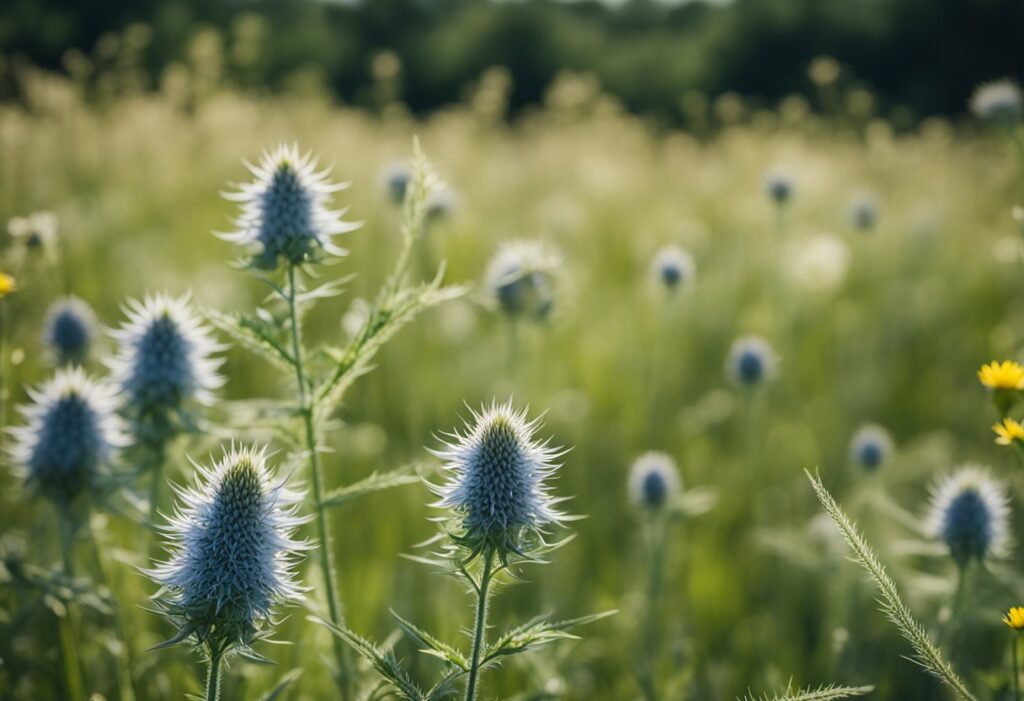
Eryngium Yuccifolium, commonly known as Rattlesnake Master, is both an ornamental and historically medicinal plant. Its unique appearance and varied applications make it notable in gardening and traditional remedies.
Gardening
When adding Rattlesnake Master to your garden, you should know it’s a perennial that thrives in areas resembling its native tallgrass prairies. It prefers full sun exposure and well-drained soil.
To grow this plant, you can sow the seeds directly in spring. For optimal results, the seeds benefit from cold stratification: chilling in a plastic bag with sand for about two months in the refrigerator before planting.
Your Rattlesnake Master will require minimal maintenance. It’s drought-resistant once established and doesn’t need frequent watering. Throughout mid-summer, you’ll see its distinctive “golf ball” flowers — greenish-white globes that attract a variety of pollinators.
Medicinal Applications
Historically, Rattlesnake Master held significant value in medicine among indigenous peoples. They used it to treat a variety of ailments, with an emphasis on its namesake use for snakebites.
Although not supported by modern medical science as an effective treatment, the plant’s past in traditional medicine is noteworthy.
The roots were the primary part used for these medicinal purposes. While you might find it an interesting addition to a garden with medicinal plants, it’s important to remember to consult professional medical advice before using any plant for health purposes.
Frequently Asked Questions

In this section, you’ll find targeted answers to common questions about the Rattlesnake Master plant, enhancing your understanding and ability to care for this unique species.
What are the ideal growing conditions for Rattlesnake Master?
Rattlesnake Master thrives in full sun and adapts to both dry and moist soil conditions. It prefers a well-drained site and can grow to a height of 4-5 feet. To mimic its natural habitat, provide conditions similar to mesic tallgrass prairies or open rocky woods.
How does Rattlesnake Master contribute to local ecosystems?
This perennial wildflower plays a significant role in its ecosystem by attracting pollinators such as bees, butterflies, skippers, and moths with its distinctive flowerheads. Its presence helps maintain the health and diversity of local flora and fauna.
What are the care requirements for maintaining a healthy Rattlesnake Master plant?
Rattlesnake Master requires minimal care once established. Ensure it has adequate sunlight and is planted in appropriate soil. It is drought-tolerant and generally does not require frequent watering or fertilization.
Can Rattlesnake Master be used for medicinal purposes, and if so, how?
Historically, the Rattlesnake Master was believed to have medicinal properties, especially in treating snake bites. However, there is limited scientific evidence to support these claims, and it should not be used as a substitute for professional medical treatment.
What are the common methods for propagating Rattlesnake Master from seeds?
Propagation by seeds is common for Rattlesnake Master. It is recommended to cold stratify the seeds by placing them in a plastic bag with sand in the refrigerator for 2 months before planting. Once stratified, sow the seeds directly in spring to avoid transplant shock.
What should be considered when sourcing Rattlesnake Master plants or seeds for cultivation?
When sourcing plants or seeds, consider the native range and habitat preferences of Rattlesnake Master. Select seeds or plants from reputable sources to ensure genetic diversity and health.
Be mindful of the species’ status in your local area and aim to support conservation efforts.



